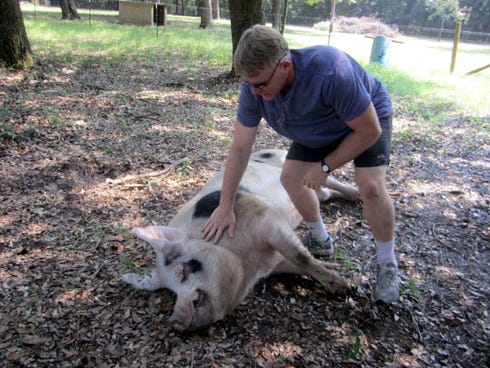
BAKER — Being approached by a lumbering 650-pound porker can be unsettling, until the hog proves he's just eager to make a new friend who'll rub his jowls and ears.
Hilltop Farm gallery photos>>
This particular pig is Peter, the breed hog on Grundel Hilltop Farm, and he has plenty of reasons to wear a big grin, including the hearty rubbing he gets from farmer Dr. Don Grundel.
Peter and his mates, Pansy and Peaches, are Gloucestershire Old Spot pigs, and thanks to a handful of pig farmers such as Grundel, their breed was rescued from the brink of extinction.
Today there are about 200 registered breeding Gloucestershire sows in the United States, and only one breeder in Florida, Grundel said. Between 300 and 500 of the pigs remain in their native England.
Almost 1,000 of the pigs in the U.S., including Peter and his family, aren't registered, Grundel said.
"They've got a great temperament," Grundel said as he rubbed Peter's snout, evoking a chorus of grunts and snorts. "Any other breed hog of this size, you'd never be able to get close to."
Gloucestershire Old Spots are pasture pigs; they prefer to forage in fields that he has planted with peas, okra, squash and, soon, rape (also known as colza), rather than being confined to a sty waiting for food.
Grundel feeds Peter and his family, including several 4-month-olds, pig chow to supplement the vegetation.
A local tradition
Though the breed is new to north Okaloosa County, raising pigs is a tradition that dates back to the region's earliest settlers.
Older residents recall the excitement of hog butchering day, when the whole family would pitch in to help produce sausages, hang meat in the smokehouse, render lard and make cracklin's.
"At the turn of the century, the pig was the No. 1 meat source around here," Grundel said. "For black residents, 90 percent of the meat they ate was pork."
George Washington Carver's first published article at the Tuskegee Normal and Industrial Institute Experiment Station instructed pig owners to harvest autumn acorns as pig feed, Grundel said.
"The pigs are acorn vacuums," Grundel said. "They love 'em. Forage pigs raised on acorns make great lard."
Very little of a slaughtered Hilltop Farm pig goes to waste. Meat is sold to a waiting list of customers, and fat is rendered into lard for cooking and soap making.
Soap making
Grundel makes scented soaps in a large cast-iron Dutch oven in the family's kitchen. As lard combines with lye and water, it produces soap and glycerol, which Grundel leaves in the soap.
"It has a moisturizing effect," he said.
Saturday morning, Grundel produced several dozen bars of lavender soap in less than an hour. As the mixture in the pot reached the right thickness, it was immediately ladled into molds.
"Sometimes it thickens so fast that he's yelling, "Bonnie, come help!'" his wife said.
After setting up overnight, the filled molds were moved to a cabinet to cure for two weeks. The couple sells the soap at festivals and fairs, including the annual Baker Heritage Festival in November.
Hilltop Farm is a hobby rather than a vocation for Don, an Eglin Air Force Base engineer, and Bonnie, a local physician assistant. They also raise a few Big Black and Berkshire pigs, horses and chickens.
"Pig farming doesn't pay the bills," he said, adding his daytime job "pays for the pigs."
Contact News Bulletin Staff Writer Brian Hughes at 850-682-6524 or brianh@crestviewbulletin.com. Follow him on Twitter @cnbBrian.
This article originally appeared on Crestview News Bulletin: Baker farm raises rare Gloucestershire pigs (GALLERY)
